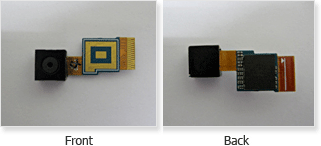Samsung Galaxy S 2 (International) Review - The Best, Redefined
by Brian Klug & Anand Lal Shimpi on September 11, 2011 11:06 AM EST- Posted in
- Smartphones
- Samsung
- Galaxy S II
- Exynos
- Mobile
Behind SGS2's Camera - Still Quality
Now the next subject is still image capture on SGS2. Before I go any further, I think now is as good at time as any to talk about what sensors are in the device. Getting to the bottom of this took some poking around, and where I started was the camera firmware. Usually getting what sensors are used in a given device is pretty straightforward - look for driver messages in dmesg when the kernel boots, and then see which ones correspond to cameras. However, on SGS2 the thing is hidden behind a custom ISP that talks over I2C to Exynos, which didn’t lead me much further than just finding out what particular ISP is onboard.
I opened the camera firmware (from /system/etc/firmware ) in a hex editor and fired away. There are number of interesting things which pop up. First up is this:
Softune REALOS/FR is Realtime OS for FR Family, based on micro-ITRON COPYRIGHT(C) FUJITSU LIMITED 1994-1999
So we know that the ISP is Fujitsu. Then there’s a line like this:
Copyright (c) 2005-2008 by FotoNation. All rights reserved. Face Detection Library v.1.2.58.7
and finally:
OBED04 Fujitsu M5MOLS
all strewn among a bunch of padded bits and compiled code incorporated into the SGS2’s “camera” firmware. So what’s the real story? Well, SGS2 uses a Fujitsu Milbeaut M–5MO ISP paired with one of two cameras. To find out which camera SGS2 uses, I took a look in Francois’ SGS2 kernel repo under the actual M5MO C driver file. Inside, there’s a line like this inside a function named “m5mo_camera_type_show”:
if (state->exif.unique_id[1] == 'B') { strcpy(type, "SONY_IMX105PQ_M5MOLS"); } else if (state->exif.unique_id[1] == 'C') { strcpy(type, "SLSI_S5K3H2YX_M5MOLS"); } else { cam_warn("cannot find the matched camera type\n"); strcpy(type, "SONY_IMX105PQ_M5MOLS"); }
So we now know that inside SGS2 is either a Sony IMX105, or Samsung S5K3H2YX sensor. This is basically the same exact camera lottery situation that the MyTouch 4G Slide is in, as it in fact has the same two exact sensors listed, though F/2.2 optics. Both are basically the same on paper and should offer similar performance - 1/3.2“ size, 1.4µm backside illuminated pixels, and 8.13 MP (3264 x 2448). The front-facing camera uses a Samsung S5K5BAF 2 MP sensor sized 1/5” and with 1.75µm square pixels.

Interestingly enough, I believe I was able to find the actual module which Samsung uses inside the SGS2 on a Samsung fiber optics website, using the Sony IMX105 module. Take note of the appearance of this module, as it’s virtually identical to what I saw inside the device as I’ll show in a moment.
Having two sensor suppliers isn’t anything new, Apple has done it (and will continue to do so), HTC is doing it, and now Samsung is doing it too. With the same on-paper sensor performance and the same autofocus + optical system module, things should all work out and photos should look the same no matter what sensor is inside.
Other specs about the camera module are that EXIF reports an F/2.7 aperture and 4.0 mm focal length. This is a bit odd to me since F/2.8 is on the typical full-stop scale (2*sqrt(2)), and then F/2.4 is a next half-stop, and I’m only aware of IMX105 coming in F/2.4 and 2.8 modules. Just goes to show that sometimes EXIF data is weird. The module is most definitely the F/2.8, f=4.15 mm variant with a 28.1 degree horizontal field of view and 4 plastic aspheric lenses.
As an aside, if this whole system sounds familiar, it’s because the Sony IMX105 module with F/2.4 optics is the oft-rumored camera going into the next iPhone.
So that brings me to the infamous magenta circle issue which numerous people have reported seeing on their SGS2s. The last time we saw this was with the iPhone 4, where a green circle is readily apparent under certain light conditions or when photographing a homogenous color or texture. Some users have reported seeing a similar magenta circle on the SGS2 camera when photographing under similar conditions, so I set out to replicate it.
 The closest I can get to the magenta circle
The closest I can get to the magenta circle
For better or worse, I can’t see the magenta circle on the SGS2 we were given, though I don’t doubt that some devices do show it. It doesn’t take much to extrapolate and come to the conclusion that is in part due to what’s becoming a CMOS lottery - now not only is there a display lottery (like what notebook buyers have been dealing with for a long time), but a CMOS lottery for sensors.
The magenta circle I see on this SGS2 is faint and nowhere near as pronounced as the green iPhone 4 circle, nor the SGS2-captured images I’ve seen online. Further, I haven’t been able to devise a method to tell which of the two possible sensors are inside this particular SGS2. I’ve taken some photos of completely white objects at a variety of focus positions and under different lighting conditions for your own perusal.
We’ve done the usual thing too and taken photos with the SGS2 inside our lightbox test scene, with the lights on and lights off. With the lights on, the SGS2 has a hard time nailing white balance with the test illuminated in auto mode, and in manual mode (set appropriately) it still has the wrong color temperature. This is just a bit unfortunate since otherwise sharpness is excellent, there’s little noise, and little to no chromatic fringing at the edges. I’m very impressed with camera performance here and would encourage viewing those images 1:1.
On the front facing camera, we get performance that looks actually surprisingly good. So good that it could actually pass for rear facing camera quality (resolution notwithstanding) of some previous generation devices.
With the lights out, the SGS2’s single LED flash illuminates the test scene nicely and gives good color temperature. SGS2 also does the right thing and fires up the LED for autofocus in the dark.
Next, we took photos with the SGS2 at the usual test locations, and it’s here that SGS2’s camera really shines. As a reminder, test locations 3, 4, 6, and 7 are the only ones remaining that I can visit, so skip 1, 2, and 5. SGS2 just really has great well-corrected sharpness and performance even out at the edges where aberrations take off, good colors without insane saturation, and great dynamic range.
Finally, I captured a large number of miscellaneous photos with the SGS2’s rear facing camera as well. I think in these real-world scenarios we get to see a better example of the SGS2’s camera performance, which is extremely good among the smartphones we’ve seen so far. Samsung also doesn’t make the mistake of putting the last vertex of the camera system behind a piece of plastic integrated into the battery cover. Instead, the module juts out through the battery cover in a way that doesn’t allow dirt and dust to collect.









































132 Comments
View All Comments
mbetter - Sunday, September 11, 2011 - link
Nice looking phone but after my last Sprint Epic turned out to be such piece of crap, I'm not getting burned again.jmcb - Sunday, September 11, 2011 - link
Sadly....this happened to me from the old Win Mo days with the Omnia 1. I kept up with the GS 1 and now the GS2...and I give Samsung credit for whatever pros the phones have.But like with any phone manufacture...a bad experience can have a lasting effect. And for me it was something simple: build quality and reception. Both were bad with the Omnia 1 IMO. And ever since....I've been leery of Samsung phones.
But...all n all the GS2 looks like more of a winner than the GS1.
warisz00r - Monday, September 12, 2011 - link
Eh, your loss. (you and the poster you're replying to)steven75 - Sunday, September 11, 2011 - link
...still doesn't have functioning GPS? Yikes!WinProcs - Sunday, September 11, 2011 - link
The GPS now works very well. It finds the satellites faster than any other smartphone I have tried including the iphone 4. Navigon is preloaded onto the phone (in Australia at least). The earlier version of Navigon had some problems on the Galaxy S. That appears to be fixed with the latest software version. The S2 has never had a problem with the GPS.I loaded Litening ROM and find that the phone is faster than original and battery life is much better too. I charge it every night but it is normally sitting at about 65-70% after an normal days use.
I had an iphone and a Galaxy S before the S2. It is better than both of those.
ph00ny - Sunday, September 11, 2011 - link
Are we reading the same article?"GPS works this time around, and works well. I took the SGS2 on a 7-hour long road trip with me and used its GPS continually with no issues."
Every review since the release has made it a point to check this and mentioned it clearly since the SGS1 debacle.
Reikon - Monday, September 12, 2011 - link
You missed the subject of the comment. He's talking about the original SGS, not the SGS2.JMS3072 - Sunday, September 11, 2011 - link
Does Hulu work using the Desktop user agent?Astri - Sunday, September 11, 2011 - link
Great review as always, but i was expecting to get more information about the famous color banding problem.Yes, the device is super etc etc, but its a pity to not be able to see everything on 24bit
supercurio - Sunday, September 11, 2011 - link
Hi Astri.In some conditions yes on Galaxy S II you can perceive gradient banding or suboptimal dithering.
The reason is not hardware at all, Super AMOLED+ controller and display work on higher bit-depth than 24bit, Gingerbread uses 32bit surfaces by default.
You can see 3 situations with degraded gradients:
- pre-dithered to 16bit or lower gradients or images
- web browser (automatic 16bit dithering)
- some games using 16bit without dithering instead of 32 on other phones.
Every available mDNIe preset apply a sharpness filter between the GPU and the screen itself. Of course, it doesn't play well with the 3 type of content listed before.
I reverse-engineered mDNIe controller registers to build a screen tuning app. Give a try to the dev snapshots: https://market.android.com/details?id=org.projectv... - root required.
The current version is basic but I'll offer complete rendering configuration in the end.
To avoid banding, use "Native" preset: as its named: no effect applied.